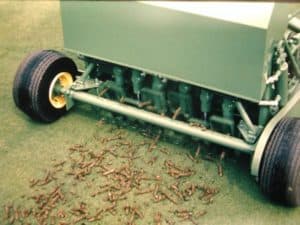Lawn aeration, as hinted in the name, is the natural process of air exchange between the soil and the atmosphere around it. It plays an important role in the healthy growth of grass by enabling more microorganisms, worms, fertilizer and water to reach lawn root systems. The more aeration occurring, the healthier, more drought-resistant a lawn will be.
By late summer, it’s common for lawns to have developed thatch, a mix of dead grass, stems, leaves and other debris. This makes it more difficult for aeration to occur naturally.
For most parts of the U.S. and Canada, August and September are ideal months to aerate lawns prior to fall fertilization, before temperatures drop and soil hardens. This will maximize the benefits of the fertilizer, strengthen the root system and foster a healthier spring lawn.
Note: Ideal timing for aeration/fertilization timing may differ in your region, as it depends on the grass type. Call your local university’s horticulture or turfgrass department or speak with staff at your local garden center about when aeration is best for your grass type.
Most landscaping businesses offer lawn aeration services but it definitely can be a do-it-yourself project, too. It’s commonly called “core aeration” in the landscaping – lawn service industry. It’s also frequently referred to as lawn cultivation, lawn or soil coring, spiking and slicing.
Do-it-yourself aeration can be done using a simple garden fork to remove small plugs of thatch and soil. For more expansive lawns, you should consider renting a lawn dethatcher and/or core aeration tool from a local home improvement store or garden center. A professional tool will enable you to cover more lawn, faster.


Happy lawn aerating!
Equipment photos courtesy of Michigan State University Department of Plant, Soil and Microbial Sciences.
Related posts
What your lawn is trying to tell you about your mower
Comments are closed.